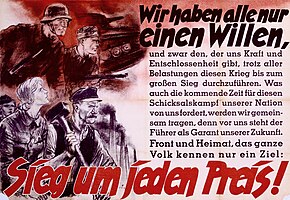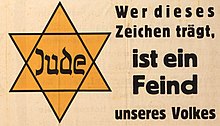Parole der Woche


Parole der Woche ("Slogan of the Week"
Establishment
Herf suggests that the Nazi artist Hans Schweitzer was influential in the establishment of Parole der Woche, which began to publish in October 1937.[4] An article in Unser Wille und Weg, the internal newsletter of the RPL, stated in June 1936:
Parole der Woche must not be absent anywhere! It is the only official party wall newspaper of the NSDAP. It presents the unified words published by the Reich Propaganda Directorate that refer to the most important prevailing political events ... Parole der Woche must penetrate every last community in the nation.[5]
On 23 September 1939, shortly after the outbreak of World War II, Nazi propaganda minister Joseph Goebbels emphasized the importance of posters to Nazi propaganda efforts, "above all" Parole der Woche.[6]
Themes and influence

Parole der Woche combined multiple styles including those of
The posters were published at the size of 135 by 54 centimetres (53 in × 21 in),
On May 5, 1943, the Reich Propaganda Directorate in Berlin informed regional propaganda offices that it was ending the Word of the Week due to the demands of war putting pressure on budgets and the calling up of more party members for active duty.
The posters were noted for their heavy use of
Spoof


From 1942 to 1945, small-sized spoof versions were produced as
References
- ^ "USHMM Artifact Gallery: Slogan of the Week". www.ushmm.org. Retrieved 9 October 2020.
- ^ a b c Herf 2006, p. 14.
- ^ .
- ^ Herf 2006, p. 29.
- ^ Herf 2006, pp. 29–30.
- ^ a b Herf 2006, p. 31.
- ^ a b Herf 2006, p. 30.
- ^ S2CID 144116639.
- ^ Herf 2006, pp. 109–110.
- ^ Herf 2006, pp. 128–129.
- ^ "Nazi propaganda poster entitled, "Das judische Komplott" ("The Jewish Conspiracy"), issued by the "Parole der Woche," a wall newspaper (Wandzeitung) published by the National Socialist Party propaganda office in Munich". United States Holocaust Memorial Museum. Retrieved 9 October 2020.
- ^ Herf 2006, p. 130.
- ^ Herf 2006, pp. 142–143.
- .
- ^ Herf 2006, pp. 28, 30.
- ^ Herf 2006, pp. 14, 28.
- ^ Herf 2006, p. 32.
- ISSN 1868-4211.
- ^ a b c d e f Richards, Lee (2004). "lack Propaganda – Parole der Woche – WWII Forged German postage stickers". PsyWar.Org. Retrieved 31 May 2020.
- ^ Heyen 1983, p. 17.
- ISBN 978-0786424580.
- ISBN 978-0752475745.
Sources
- Gjems-Onstad, Erik (1981). Psykologisk krigføring i Norge: Durham – hemmelige operasjoner i Trøndelag mot tysk okkupasjonsmakt 1943–45 (in Norwegian). Sollia. ISBN 978-8290346015.
- ISBN 978-0674038592.
- ISBN 978-3423029360.
- Schmidt, Palle (1982). Sort propaganda (in Danish). Frihedsmuseets Venner. OCLC 895020078.
External links
- Many issues for view at United States Holocaust Memorial Museum website
- Issues at Randall Bytwerk's website
